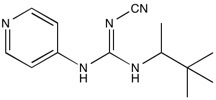Pinacidil | Potassium channel opener
NMR (Conforms)

Available Options
| Size : | Price | Quantity | |
|---|---|---|---|
| 10 mg | $30.00 | ||
| 50 mg | $120.00 |
Pinacidil (85371-64-8) activates ATP-dependent potassium channels.1,2 Induces vascular relaxation and antihypertensive effects.3 Prevents the loss of mitochondrial inner membrane potential, protecting cerebellar granule neurons from apoptosis induced by oxidative stress.4 Displays protective effects in Parkinson’s disease models5 and cerebral ischemia-reperfusion6.
References/Citations:
1) Hermsmeyer et al. (1988), Pinacidil actions on ion channels in vascular muscle; J. Cardiovasc. Pharmacol., 12(Suppl. 2) S17
2) Gollasch et al. (1995), Pinacidil relaxes porcine and human coronary arteries by activating ATP-dependent potassium channels in smooth muscle cells; J. Pharmacol. Exp. Therap., 275 681
3) Cohen & Kurz (1988), Pinacidil-induced vascular relaxation: comparison to other vasodilators and to classical mechanisms of vasodilation; J. Cardiovasc. Pharmacol., 12(Suppl. 2) S5
4) Teshima et al. (2003), Mitochondrial ATP-sensitive potassium channel activation protects cerebellar granule neurons from apoptosis induced by oxidative stress; Stroke, 34 1796
5) Xie et al. (2010), K(ATP) channel openers protect mesencephalic neurons against MPP+-induced cytotoxicity via inhibition of ROS protection; J. Neurosci. Res., 88 428
6) Zhang et al. (2008), Effects of ATP sensitive potassium channel opener on the mRNA and protein expressions of caspase-12 after cerebral ischemia-reperfusion in rats; Neurosci. Bull., 24 7
NMR (Conforms)
Safety Data Sheet:
Product Data Sheet:
Materials provided by Focus Biomolecules are for laboratory research use only and are not intended for human or veterinary applications. Please note that we do not sell to individuals and that all orders placed by non-research organizations will incur a $20 restocking/refund fee
Pinacidil (85371-64-8) activates ATP-dependent potassium channels.1,2 Induces vascular relaxation and antihypertensive effects.3 Prevents the loss of mitochondrial inner membrane potential, protecting cerebellar granule neurons from apoptosis induced by oxidative stress.4 Displays protective effects in Parkinson’s disease models5 and cerebral ischemia-reperfusion6.
References/Citations:
1) Hermsmeyer et al. (1988), Pinacidil actions on ion channels in vascular muscle; J. Cardiovasc. Pharmacol., 12(Suppl. 2) S17
2) Gollasch et al. (1995), Pinacidil relaxes porcine and human coronary arteries by activating ATP-dependent potassium channels in smooth muscle cells; J. Pharmacol. Exp. Therap., 275 681
3) Cohen & Kurz (1988), Pinacidil-induced vascular relaxation: comparison to other vasodilators and to classical mechanisms of vasodilation; J. Cardiovasc. Pharmacol., 12(Suppl. 2) S5
4) Teshima et al. (2003), Mitochondrial ATP-sensitive potassium channel activation protects cerebellar granule neurons from apoptosis induced by oxidative stress; Stroke, 34 1796
5) Xie et al. (2010), K(ATP) channel openers protect mesencephalic neurons against MPP+-induced cytotoxicity via inhibition of ROS protection; J. Neurosci. Res., 88 428
6) Zhang et al. (2008), Effects of ATP sensitive potassium channel opener on the mRNA and protein expressions of caspase-12 after cerebral ischemia-reperfusion in rats; Neurosci. Bull., 24 7
Calculate the molar concentration, mass or volume in a solution.
Concentration × Volume × Molecular Weight = Mass
Focus Biomolecules • Plymouth Meeting, PA USA • 1-855-FOCUS21
Focus Biomolecules
Plymouth Meeting, PA USA
1-855-FOCUS21
Website Created by Advanta Advertising LLC.

